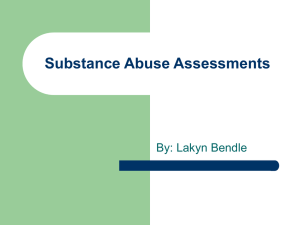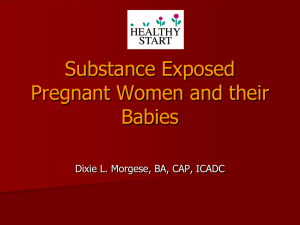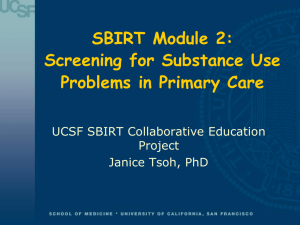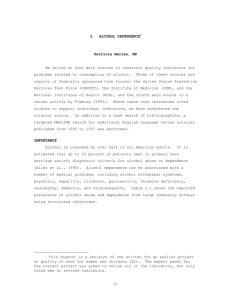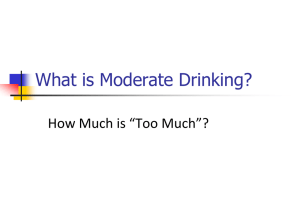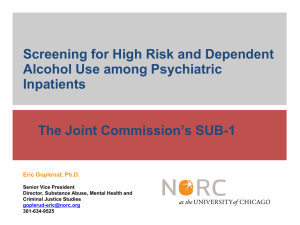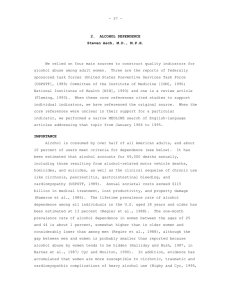Screening and Brief Intervention - California Society of Addiction
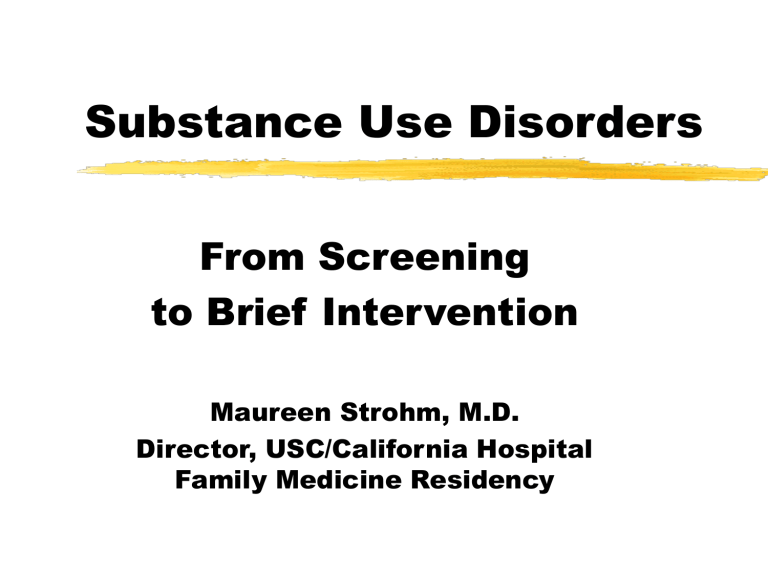
Substance Use Disorders
From Screening to Brief Intervention
Maureen Strohm, M.D.
Director, USC/California Hospital
Family Medicine Residency
So what’s the problem?
>1000 tobacco-related deaths/day
about 100 deaths/d due to 2nd hand smoke
>300 alcohol-related deaths/day
Nearly 100 drug-related deaths/day
LIFETIME PREVALENCE AODA 11-16%
for men, as high as 23% over lifetime
15-20% primary care patients with AODA
Substance Use Continuum:
All levels carry risk
Abstinence: PH or FH
Non-problem Use: “social use”
Problem Use: public health issue, gray issue
Abuse: 50% may progress to dependence
Dependence: abstinence is ONLY option
CDC/PHS Guidelines
Moderate Drinking
Men <2 drinks/d, < 10 drinks/wk, 4 drink tolerance
Women/ All over 65 <1 drink/d, < 7/wk, 3 drink tolerance
“At risk” or “Hazardous” Drinking
Men >4 drinks per occasion, >10 drinks/wk
Women >3 drinks per occasion, >7 drinks/wk
> 2 on CAGE Questions
“Problem Drinking/Using” or Abuse is...
A Maladaptive pattern of alcohol or substance use leading to
Major Roles: Problems at work, school or home.
Physical Hazards: Using while driving car.
Legal Entanglements: Bankruptcy
Social Difficulties: arguments with spouse, fights
(Health Consequences): Pancreatis, Ulcers, Fractures
(DSM-IV, 1994)
Spectrum of Substance Use
Disorders in Primary Care
At-Risk
….possible problems in 3-5 years
Problem Use
…non-compulsive use associated with negative consequences.
Dependence
…compulsive use, loss of control and associated negative consequences.
Goals with Each Patient
Prevention
Screening and Assessment
Brief Intervention
heavy use or problem use
Full Intervention
if abuse or dependence identified
Goals with Each Patient
ASK: Direct and/or indirect screening
ASSESS: change
Point on continuum, Readiness for
ADVISE: Educational feedback, CDC guidelines
ASSIST: measures geared for preparation and action steps
ARRANGE: follow-up, re-screen, referral
BEYOND Brief Intervention:
Formal Treatment
DSM IV: Substance Abuse Disorders
use-related problems at work, home, school
use when physically hazardous
use despite problems
DSM IV: Substance Dependence Disorders
tolerance or withdrawal
use-related focus, unsuccessful at control
continued use despite consequences
better definition - adds addictive patterns of use
Dependence:
Better Definition
Three C’s...
Compulsion to Use
Loss of Control
Neg. Consequences
ASK!!
Screening and Assessment
Routine History - Medication Review
Direct Questions
Quantity-frequency, short question(s)
AUDIT
Indirect Screening
CAGE Questions
T-ACE for women
MAST
ASK!!
Routine History
Use Medication Review as entry point:
What Rx drugs are you taking?
What about OTC drugs?
Tell me about your own drugs…
caffeine, tobacco
What about alcohol…marijuana...cocaine… IV drugs?
Move on to the direct question(s)
ASK!!
“
Traditional” questions
Simple quantity/frequency questions are very insensitive (34-47%):
How much? How often? (think of our games of interpretation!)
More sensitive (Cyr and Wartman, 1988):
When was your last drink?
Have you ever had problems due to alcohol use?
Even Better!
Single Question
When was the last time you had more than “X” drinks in 1 day?
(Never, >12 mon, 3-12 mon, <3 mon)
X = 5 drinks for men, X = 4 drinks for women
Sensitivity = 88% men, 83% women, overall 86%
Specificity = 81% men, 91% women, overall 86 %
Williams & Vinson, 2001, ER patients with injuries
ASK!
Direct Screening
More specific approach to quantity/frequency
consumption per week, per occasion
Medication History: Rx -> OTC -> “Personal drugs”
(caffeine, tobacco, alcohol, others)
Simple tools/questionnaires
Direct screening: Simple questions, AUDIT
Focus on patterns and amount of use
ASK!
Indirect Screening
Identify patient/family risk for problems
determine problems related to use
Simple tools/questionnaires
CAGE, T-ACE
Gender differences in consequences
Men have more legal consequences
DUI, disorderly conduct, violence
Women have more relational problems
PH/FH of physical + sexual abuse
CAGE Questions:
Indirect Screen/Assessment
Have you ever felt the need to your drinking (or using)?
CUT DOWN on
Has anyone ANNOYED drinking (or using)?
you by criticizing your
Have you ever felt bad or drinking (or using)?
GUILTY about your
Have you ever had a drink to settle your nerves or get rid of a hangover? (EYE-OPENER)
91% sensitivity, 77% specificity
T-ACE
Developed for use in pregnant women
Substitutes Tolerance for Guilt for women
> 2 drinks for a high indicates increasing tolerance
ASSESS!
Point on Continuum / Risk Status
At-Risk
Exceed recommended guidelines.
Problem Drinker/User …
Review associated problems.
Dependent
Compulsion & Loss Control
CAGE>=2
ASSESS!
Level of Risk/Readiness for Change
History MOST important
Physical Examination
Not good for early assessment!
Blood pressure is one exception
2-3 drinks/day may raise BP to HTN levels
Labs - Most insensitive for screening
“best” = BAC, GGT, MCV
Other “Studies” Families live with problem drinkers for 7-8 yr before seeking help
Raising the Red Flags:
Enter the 5As from a different angle
During H/P, episodic visits, PE or labs for other reasons
Frequent URIs, bronchitis, pneumonia
Chronic pain syndromes: HA, neck pain, LBP
Chronic “stress” syndromes: anxiety, depression, insomnia, GI complaints
Injuries and accidents
Explore the use of alcohol/drugs to treat symptoms
ASSESS! Physical exam
Skin changes rosacea, rhinophima, bruises, spider angiomata
HEENT conjunctival injection
Lungs associated COPD changes
Heart arrhythmias, tachycardia, cardiomegaly
Abdomen liver enlargement, tenderness, ascites
Extremities - vascular changes, nicotine stains
ASSESS!
FAMILY as “Screening Tool”
Co-dependent families:
Higher rate of health care utilization
Similar cluster on nonspecific problems:
headaches, back pain, GI complaints
anxiety or depressive disorders
Adolescents as “identified patient”
Families live with problem drinkers for 7-8 years before seeking help
ASSESS!
Readiness for Change
Precontemplation
Relapse Contemplation
Preparation
Maintenance
Action
(Prochaska, DiClemente, Psychother Theory Res Pract. , 1982)
Readiness for Change
Each stage requires a unique message
Precontemplation …Unaware of problem
Contemplation.
....Weighs Risks/Benefits
Preparation …....Makes Decision &Plans
Action ………...Practices New Behaviors
Maintenance ………..Sustaining Change
Relapse ………….………………...Oops!
ADVISE!
Non-judgemental approach critical
Simple advice about consequences:
CDC guidelines for moderate drinking
Hazards of continued use (physical, interpersonal, legal)
Potential for addiction (especially if +PH/FH, current crises)
ASSIST! Steps to Intervene
Brief Intervention
patient at risk due to PH/FH, current use patterns
Further assessment, education, motivational counseling, follow-up
Full Intervention
patient meeting criteria for dependence
“problem-user” patient who fails brief intervention
ARRANGE!
Monitor use and problems
Ongoing assessment at follow-up
Repeated screening at regular intervals
at medical, psychosocial, family crises
preventive health visits
Referral for addiction consultation if questions remain
Targeting Substance Use
Interventions
At Risk
Problem Use
Sub. Dependence
“Cut Back”
Brief Intervention
Motivational
Interviewing
Formal CD Tx
Moving to Brief Intervention
What is it? Time-limited strategy
5 minutes -> 1 hour
1 - 5 sessions
Most studies used 10-15 minute session
Brief advice, self-help booklets, weekly diaries of use
Written contract with physician
BRIEF INTERVENTION
What is the aim?
Prevention or elimination of problems
Reducing/eliminating use
Eliminating/reducing risk of harm
BRIEF INTERVENTION:
Effectiveness
Over 40 controlled trials
Even control subjects reduced use 10-
30% at 1 year follow-up
66%-74% reduction in quantity/frequency of use (men - women), with 5-15 min physician advice
fewer binge episodes, reduction in total use
improved liver function (reduced GGT levels)
BRIEF INTERVENTION:
Key studies
WHO:
10 countries, >1600 nondependent drinkers
3 protocols + 10 item AUDIT questionnaire
similar results for simple advice group as for extended counseling + 3 follow-up sessions
British Study (1988): 909 heavy drinkers
Project TrEAT (1997): 776 at-risk drinkers
reduced consumption: 39% fewer drinks/wk (18% in controls)
47% fewer binge episodes (21% in controls)
fewer in-hospital days though same # ER visits
Summary of Studies
SIMPLY ASKING reduces use and subsequent problems at follow-up (10-30%)
Brief Intervention results in further reduction of use (30-50%), often to “safe” levels
Failure of brief intervention suggests diagnosis of dependence
BEYOND BRIEF INTERVENTION
What’s next?
Initiation of recovery
Detox = PREPARATION FOR TREATMENT
Formal Intensive CD Treatment Programs
introduction to concepts and recovery
day treatment, inpatient, medical vs social model
Long Term Remission
12 Step participation shows best chance for remission
Remember!
Screening:
important throughout the life cycle
Simply asking about use can reduce use
a form of brief intervention by itself
Single question: When was the last time you had more than X drinks in one day? (men=5, women=4)
Simple tools for brief visit:
AUDIT for detailed direct screening
CAGE, T-ACE for further assessment
Remember!
Stage-based intervention can speed the process through the cycles of change
Motivational counseling places the patient perspective and needs …and responsibility… at the center
Failure of brief intervention suggests dependence - need for formal treatment
Intervening with the family can enhance the health of family members …
… and may break the cycle of co-dependence and lead to recovery for addicted member
